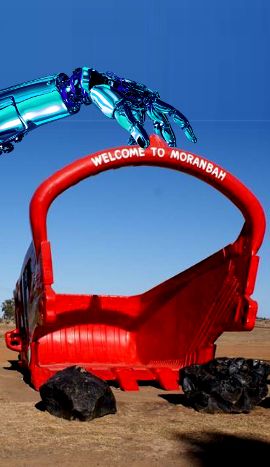Uni and industry combine to bring big mining robots online
 Over half a million dollars will be spent on a trial to introduce automated draglines; robots that could save millions for mines worldwide.
Over half a million dollars will be spent on a trial to introduce automated draglines; robots that could save millions for mines worldwide.
Resources technology firm MineWare is collaborating with researchers from CRCMining and the University of Queensland on an 18-month project aimed at advancing dragline operations through automation.
Unions are concerned about the potential job losses for dragline operators, but the increased capacity and lower cost of high-tech approaches could create many more jobs down the line.
The Australian Coal Industry Research Program (ACARP) has put up $600,000 for the joint R&D project.
A key part of the tests will involve the design and implementation of new dig sequencing technology. It will use sensors and other technologies to identify the best sequence of actions and movements to excavate most efficiently.
MineWare CEO and project co-leader Andrew Jessett says productivity is the aim.
“On draglines around the world, we continue to see inconsistencies in operator sequences and techniques, which can result in variations in productivity rates in excess of 10 per cent,” he said.
“By giving dragline operators accurate, instant guidance, we want to close the gap on these variations and improve productivity as a direct result.”
Jessett says human operators should not fear the robot revolution just yet.
“This project builds upon more than 20 years of initiatives aimed at improving the performance of draglines,” he said.
“While the dream of an automated dragline system is still many, many years away, we’re ready to take another big step, harnessing new digital terrain mapping technology and our Pegasys Dragline Production Monitor to semi-automate key dragline dumping and positioning functions.”
“Consistency is very important, that range of variability between operators can be anywhere up to 10 or 15 per cent and in dollar terms that's very significant.
“When a dragline's cost is around $30,000 an hour, when you've got 10 or 15 per cent variation in that hour by hour, that [adds up to] a lot of money over a period of time.”
The project is just the latest in an ongoing series from ACARP, as it pushes to bring about a new age of resource gathering.
The automation research has been split into two major stages.
The first stage will see the design of an advanced excavation sequencing system, which it is hoped will develop an algorithmic approach that can be applied to dragline operations around the world.
The second stage will test the algorithm on an actual production dragline, integrated into computerised monitoring systems. In this stage, operator visualisation and supervisor report tools will be used to compare operator-based sequencing against the excavation sequencing algorithm.
MineWare’s Andrew Jesset says decision-making is a key factor in dragline productivity.
“There is a direct link between operator performance and dragline productivity, particularly when it comes to excavation planning,” he said.
“Only the very best dragline operators are well skilled in this area; they need to know when to reposition a dragline, what the optimal sequence of moves is to dig a block and how the dragline should move to get there.”
“The answers to these questions lie at the very heart of dragline efficiency and productivity. By creating a system that allows us to get dig sequencing right every time, we will have made a significant step forward towards automation.”
The CFMEU has welcomed any improvements to mine safety, but says they should not come at the expense of the workforce.
“Companies at the moment are obviously reducing their staff and I'd hate to think that if there's an introduction of a new process or that's being done for other means to actually reduce the amount of people that carry out a task,” CFMEU district president Stephen Smyth has told the ABC.
“Obviously we're always mindful that if suddenly something is introduced and it's all about reducing a standard or a process that's already in place, so it's obviously a monitor and watch situation.”
Rio Tinto CEO Sam Walsh has recently commented that Australia must maintain its competitiveness through the progressive “robotisation” of its mining workforce.








 Print
Print